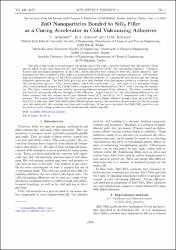| dc.contributor.author | Açıkgöz, C. | |
| dc.contributor.author | Sahbaz, D. A. | |
| dc.contributor.author | Koçkar, Ömer Mete | |
| dc.date.accessioned | 2019-10-21T21:11:54Z | |
| dc.date.available | 2019-10-21T21:11:54Z | |
| dc.date.issued | 2017 | |
| dc.identifier.issn | 0587-4246 | |
| dc.identifier.issn | 1898-794X | |
| dc.identifier.uri | https://dx.doi.org/10.12693/APhysPolA.131.200 | |
| dc.identifier.uri | https://hdl.handle.net/11421/21206 | |
| dc.description | 6th International Congress and Exhibition on Advances in Applied Physics and Materials Science (APMAS) -- JUN 01-03, 2016 -- Istanbul, TURKEY | en_US |
| dc.description | WOS: 000396118600057 | en_US |
| dc.description.abstract | The aim of this study is to investigate the interaction of ZnO/SiO2 particles between the chloroprene rubber and its effect on the cure characteristics and mechanical properties of the cold vulcanizing adhesives. Curing efficiency and mechanical properties of ZnO/SiO2 filled adhesives were compared with SiO2 filled adhesives. ZnO nanoparticles were bounded to SiO2 spherical nanoparticles by hydrolysis and condensation process. The morphology and elemental content of ZnO/SiO2 particles were investigated by scanning electron microscopy and energy dispersive spectroscopy. The ZnO/SiO2 particles were then blended with chloroprene rubber as accelerator during the vulcanization process. Cure characteristics, which are scorch time (t(s2)), cure time (t(c90)), maximum torque (M-H) and minimum torque (M-L) of the rubber compounds were determined at 190 degrees C with a moving die rheometer. The fabric conveyor belt was used for measuring adhesive strength of the adhesives. The fabric conveyor belt was used for measuring adhesive strength of the adhesives. Application of the cold vulcanizing adhesives to the fabric conveyor belt was carried out at three different times (4, 8, and 24 h),25 degrees C temperature and 0.3 kg/cm(2) pressure. The results showed that ZnO/SiO2 particles provided a higher adhesive strength than silica in the 4, 8, and24 h of adhesion. ZnO/SiO2 filled rubber blends gained superior vulcanization characteristics by the increasing cure rate index with the reducing cure time and scorch time. It has been concluded that ZnO/SiO2 particles can be used as a new curing accelerator and simultaneously reinforcing filler. | en_US |
| dc.description.sponsorship | Bilecik Seyh Edebali University, Turkey [2015-01.BSEU.03-03] | en_US |
| dc.description.sponsorship | This study has been supported by Scientific Project 2015-01.BSEU.03-03 from Bilecik Seyh Edebali University, Turkey. The authors would like to thank BILLAS Tire & Rubber Industry and Trade Inc. and OZER-BAND Conveyor Belt Industry and Trade Inc., Turkey for assisting this research. | en_US |
| dc.language.iso | eng | en_US |
| dc.publisher | Polish Acad Sciences Inst Physics | en_US |
| dc.relation.isversionof | 10.12693/APhysPolA.131.200 | en_US |
| dc.rights | info:eu-repo/semantics/openAccess | en_US |
| dc.title | ZnO Nanoparticles Bonded to SiO2 Filler as a Curing Accelerator in Cold Vulcanizing Adhesives | en_US |
| dc.type | conferenceObject | en_US |
| dc.relation.journal | Acta Physica Polonica A | en_US |
| dc.contributor.department | Anadolu Üniversitesi, Mühendislik Fakültesi, Kimya Mühendisliği Bölümü | en_US |
| dc.identifier.volume | 131 | en_US |
| dc.identifier.issue | 1 | en_US |
| dc.identifier.startpage | 200 | en_US |
| dc.identifier.endpage | 203 | en_US |
| dc.relation.publicationcategory | Konferans Öğesi - Uluslararası - Kurum Öğretim Elemanı | en_US |
| dc.contributor.institutionauthor | Koçkar, Ömer Mete | |


















